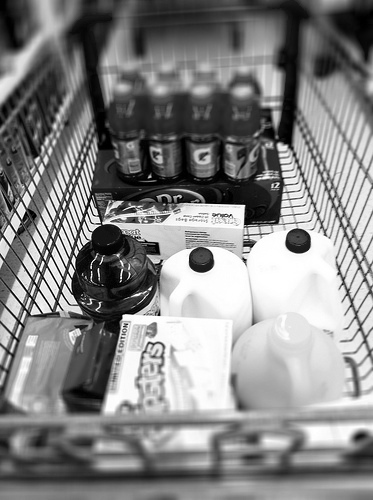 If you are trying to live a greener, simpler life, you are probably already avoiding packaged food. In general, I avoid over packaged food because of the amount of garbage it is adding to our landfills or energy used to recycle. Sometimes I make an exception for [amazon_link id=”B000HVX6NK” target=”_blank” container=”” container_class=”” ]seaweed snacks[/amazon_link] or Trader Joe’s (yes, I am a hypocrite), but extra garbage or recycling is not the only reason to avoid food packaging. According to a new study, food packaging is a major source of human exposure to the toxic chemicals BPA and DEHP.
If you are trying to live a greener, simpler life, you are probably already avoiding packaged food. In general, I avoid over packaged food because of the amount of garbage it is adding to our landfills or energy used to recycle. Sometimes I make an exception for [amazon_link id=”B000HVX6NK” target=”_blank” container=”” container_class=”” ]seaweed snacks[/amazon_link] or Trader Joe’s (yes, I am a hypocrite), but extra garbage or recycling is not the only reason to avoid food packaging. According to a new study, food packaging is a major source of human exposure to the toxic chemicals BPA and DEHP.
Bisphenol-A (BPA) has been all over the news for years, and many families avoid BPA containing plastics; however, even those can leach hormone disrupting chemicals into our food and drink. Bis(2-ethylhexyl)phthalate (DEHP) is a plasticizer commonly used in the production of PVC and is the “most important” phthalate. Both chemicals are considered safe by the US government, although BPA is being investigated. Despite governmental assurances, these are chemicals of concern commonly found in food packaging.
Discovery News explains the new study:
To solidify the link from food packaging to human exposure, Rudel and colleagues altered the diets of 20 Bay-Area families, each with two adults and two kids. All of the households reported that they either drank from polycarbonate water bottles, dined out at restaurants, microwaved food in plastic containers, ate canned foods or frozen dinners, or used plastic storage materials — all of which would suggest exposure to at least some chemicals of concern.
During an eight-day study, the researchers took urine samples from participants on a nightly basis to look for evidence of both BPA and four types of phthalates.
For a couple days at both the beginning and end of the week, families stuck with their normal diet. But for three days in the middle of the study, they ate only food that was prepared for them by a caterer who conformed to specific guidelines.
The majority of food was fresh. Cans were not allowed. Food preparers avoided using plastic utensils or nonstick cookware. Food and drinks were stored in glass or stainless steel containers at levels low enough that the contents did not touch BPA-free lids. Even coffee had to be made in a French press or ceramic drip so that no plastic was involved.
During the three-day intervention, average levels of BPA in people’s urine dropped by 66 percent, the researchers report today in the journal Environmental Health Perspectives. The highest measured levels dropped by 75 percent. For DEHP, average levels of certain breakdown products dropped by more than 50 percent, and maximum measured levels dropped by 95 percent.
Although the news is rather bleak about chemical contamination from food packaging, the rapidity at which this chemical exposure can be reduced is encouraging. Just three days of eating fresh, whole foods causes the body burden results to drop by more than 50 percent!
Discovery News offers these great simple steps to keep your family safe from BPA and phthalates:
- Eating mostly fresh foods and avoiding cans and plastic containers can drastically reduce the levels of these chemicals in our bodies.
- A combination of shopping habits and legislation may be key to limiting human exposures to the ubiquitous chemicals.
It may be impossible to completely eliminate exposure to toxic chemicals, but at least we can make wise food choices by avoiding packaging.
Photo: ![]() Some rights reserved by sampitech
Some rights reserved by sampitech
Do you know if PVC piping in new houses has the DEHP in it?
Good question! I’ve always been concerned about lead in PVC pipes, but apparently it is not used as a stabilizer in North America (although I don’t really know that for sure).
http://tsac-pvc.obiki.org/stabilizers.html
DEHP makes PVC more flexible, like in medical tubing, so I would think it would not be present or as in high of a quantity in the pipe since it is rigid. That doesn’t mean that PVC is entirely safe. We have it coming from our spring to our home, but I don’t trust it. Here’s more info on that:
http://www.healthybuilding.net/pvc/HBN_FS_PVC_in_Buildings.pdf
It is certainly toxic to produce and releases a host of dioxins on nearby communities.
http://www.buildinggreen.com/auth/article.cfm/1994/1/1/Should-We-Phase-Out-PVC/
It’s pretty amazing how much the levels can drop in so short a time. I like to do as much fresh cooking as I can, but it’s challenging a lot of the time. This is just more motivation to find more ways to avoid plastics.